Constantine I of Greece - Picture
More about World War 1
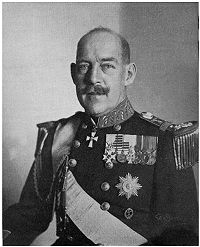
|
|
Constantine I of Greece

Picture - King of the Hellenes
Reign: 18 March 1913 - 11 June 1917
Predecessor: George I
Successor: Alexander
: King of the Hellenes
Reign: 19 December 1920 - 27 September 1922
Predecessor: Alexander
Successor: George II
:
Spouse: Sophie of Prussia
Issue:
: George II of Greece
Alexander of Greece
Helen, Queen of Romania
Paul of Greece
Princess Irene, Duchess of Aosta
Princess Katherine
House: House of Schleswig-Holstein-Sonderburg-Glx╝cksburg
Father: George I of Greece
Mother: Olga Constantinovna of Russia
Born: 2 August 1868(1868-08-02)
Athens, Greece
Died: 11 January 1923(1923-01-11) (aged 54)
Palermo, Italy
Burial: 22 November 1936
Royal Cemetery, Tatoi Palace, Greece
Religion: Greek Orthodox
Constantine I ( 2 August [O.S. 21 July] 1868 - 11 January 1923) was King of the Hellenes from 1913 to 1917 and from 1920 to 1922. He was commander-in-chief of the Hellenic Army during the unsuccessful Greco-Turkish War of 1897 and led the Greek forces during the successful Balkan Wars of 1912-1913, in which Greece won Thessaloniki and doubled in area and population. He succeeded to the throne of Greece on 18 March 1913, following his father's assassination.
His disagreement with Eleftherios Venizelos over whether Greece should enter World War I led to the National Schism. Constantine forced Venizelos to resign twice, but in 1917 he left Greece, after threats of the Entente forces to bombard Athens; his second son, Alexander, became king. After Alexander's death, Venizelos' defeat in the 1920 legislative elections, and a plebiscite in favor of his return, Constantine was reinstated. He abdicated the throne for the second and last time in 1922, when Greece lost the Greco-Turkish War of 1919-1922, and was succeeded by his eldest son, George II. Constantine died in exile four months later.
Early life
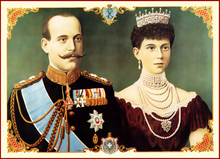
Picture - King Constantine I and Queen Sophia.
Born on 2 August 1868 in Athens, Constantine was the eldest son of King George and Queen Olga of Greece. His birth was met with an immense wave of enthusiasm: the new heir apparent to the throne was the first Greek-born royal. As the ceremonial cannon on Lycabettus Hill fired the Royal salute, huge crowds gathered outside the Palace shouting what they thought should rightfully be the newborn prince's name: "Constantine". This was not only the name of his maternal grandfather, Grand Duke Konstantin Romanov of Russia, but also the name of the "King who would reconquer Constantinople, the "future Constantine XII, legitimate successor to Emperor Constantine XI Palaiologos", according to popular legend. Upon his birth, he was created Duke of Sparta. This resulted in a heated dispute in parliament, since the constitution did not allow any titles of nobility to be conferred to Greek citizens, but the purely titular dignity was eventually awarded. He was inevitably christened "Constantine" (Greek: ╬ܤë╬Ż¤â¤ä╬▒╬Ż¤äß┐ľ╬Ż╬┐¤é, K┼Źnstant─źnos) on 12 August, and his official style was the Dixídochos (╬ö╬╣╬Č╬┤╬┐¤ç╬┐¤é, Crown Prince, literally: "Successor"). The most prominent university professors of the time were handpicked to tutor the young Crown Prince: Ioannis Pantazidis taught him Greek literature; Vasileios Lakonas mathematics and physics; and Constantine Paparrigopoulos history, infusing the young prince with the principles of the Megali Idea. On 30 October 1882 he enrolled in the Hellenic Military Academy. After graduation he was sent to Berlin for further military education, and served in the German Imperial Guard. Constantine also studied political science and business in Heidelberg and Leipzig. In 1890 he became Major General, and assumed command of the 3rd Army Headquarters (╬ô' ╬Ťü¤ç╬Ě╬│╬Á╬»╬┐╬Ż ╬ú¤ä¤ü╬▒¤ä╬┐¤Ź) in Athens.
Confrontations with Trikoupis
In January 1895, Constantine caused political turmoil when he ordered army and gendarmerie forces to break up a street protest against tax policy. Constantine had previously addressed the crowd and advised them to submit their grievances to the government. Prime Minister Charilaos Trikoupis asked the King to recommend that his son avoid such interventions in politics without prior consultation with the government. King George responded that the Crown Prince was, in dispersing protesters, merely obeying military orders, and that his conduct lacked political significance. The incident caused a heated debate in Parliament, and Trikoupis finally resigned as a result. In the following elections Trikoupis was defeated, and the new Prime Minister, Theodoros Deligiannis, seeking to downplay hostility between government and the Palace, regarded the matter closed.
The organization of the first modern Olympics in Athens was another issue which caused a Constantine-Trikoupis confrontation, with Trikoupis opposed to hosting the Games. After Deligiannis' electoral victory over Trikoupis in 1895, those who favored a revival of the Olympic Games, including the Crown Prince, prevailed. Subsequently, Constantine was instrumental in the organization of the 1896 Summer Olympics; according to Pierre de Coubertin, in 1894 "the Crown Prince learned with great pleasure that the Games will be inaugurated in Athens." Coubertin assured that "the King and the Crown Prince will confer their patronage on the holding of these Games." Constantine later conferred more than that; he eagerly assumed the presidency of the 1896 organizing committee. At the Crown Prince's request, wealthy businessman George Averoff agreed to pay approximately one million drachmas to fund the restoration of the Panathinaiko Stadium in white marble.
Greco-Turkish War and aftermath
Constantine was the commander-in-chief of the Greek Army in the Greco-Turkish War of 1897, which ended in a humiliating defeat. In its aftermath, the popularity of the monarchy fell, and calls were raised in the army for reforms and the dismissal of the royal princes, and especially Constantine, from their command posts in the armed forces. The simmering dissent culminated in the Goudi coup in August 1909. In its aftermath, Constantine and his brothers were dismissed from the armed forces, only to be reinstated a few months later by the new Prime Minister, Eleftherios Venizelos, who was keen on gaining the trust of King George. Venizelos was ingenious in his argumentation: "All Greeks are rightly proud to see their sons serve in the army, and so is the King". What was left unsaid was that the royal princes' commands were to be on a very tight leash.
Balkan Wars
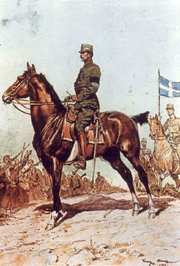
Picture - King Constantine I during the Second Balkan War, by Georges Scott.
Overview
Turkish planning was foreseeing a two-prong Greek attack east and west of the impassable Pindus mountain range, and they accordingly allotted their resources, equally divided, on a defensive posture in order to fortify the approaches to Ioannina, capital of Epirus, and the mountain passes leading from Thessaly to Macedonia. This was a grave error. The war plan by Venizelos and the General Staff called for a rapid advance with overwhelming force towards Thessaloniki with its vitally important harbor. A minute force of little more than a division proper, just enough to forestall a possible Turkish redeployment eastwards, was to be sent west as the "Army of Epirus", while the bulk of the army and artillery would embark on what would later be called "blitzkrieg" tactics against the Turks in the east. In the event the Greek plan worked brilliantly: advancing on foot, the Greeks defeated the Turks soundly twice, and were in Thessaloniki within 4 weeks. The Greek plan for overwhelming attack and speedy advance hinged upon another factor: should the Greek Navy succeed in blockading the Turkish fleet within the Straits, any Turkish reinforcements from Asia would have no way of reaching Europe fast. Turkey would be slow to mobilize, and even when the masses of loyal troops raised in Asia were ready, they could go no further than the outskirts of Istanbul, fighting the Bulgarians in brutal trench warfare. With the Bulgarians directing the bulk of their force towards Constantinople, capture of Thessaloniki would ensure that the railway axis between these two main cities was lost to the Turks, who would then suffer total loss of logistics and supplies and severe impairment of command and control capability. The Turks would be hard placed to recruit locals, as their loyalties would be liable to lie with the Balkan Allies. Ottoman armies in Europe would be quickly cut off and their loss of morale and operational capability would lead them toward a quick surrender.
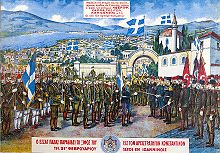
Picture - Greek lithography showing the surrender of Ioannina by Essat Pasha to Constantine I during the First Balkan War.
Macedonian Front
Previously the Inspector General of the Army, Constantine was appointed commander-in-chief of the Greek "Army of Thessaly" when the First Balkan War broke out in October 1912. He led the Army of Thessaly to victory at Sarantaporos. At this point, his first clash with Venizelos occurred, as Constantine desired to press north, towards Monastir, where the bulk of the Ottoman army lay, and where the Greeks would rendezvous their Serb allies. Venizelos, on the other hand, demanded that the army capture the strategic port city of Thessaloniki, the capital of Macedonia, with extreme haste, so as to prevent its fall to the Bulgarians. The dispute resulted in a heated exchange of telegrams. Venizelos notified Constantine that "... political considerations of the utmost importance dictate that Thessaloniki be taken as soon as possible". After Constantine impudently cabled: "The army will not march on Thessaloniki. My duty calls me towards Monastir, unless you forbid me", Venizelos was forced to pulled rank. As Prime Minister and War Minister, he outranked Constantine and his response was famously three-words-long, a crisp military order to be obeyed forthwith: "I forbid you". Constantine was left with no choice but to turn east, and after defeating the Ottoman army at Giannitsa, he accepted the surrender of the city of Thessaloniki and of its Ottoman garrison on 27 October (O.S.), less than 24 hours before the arrival of a Bulgarian force of two battalions dispatched on horseback in the hope of reaching the city first.
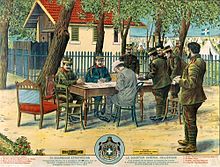
Picture - Constantine confers with Prime Minister Eleftherios Venizelos and members of the Greek General Staff prior to the Conference of Bucharest that ended the Balkan Wars.
The capture of Thessaloniki against Constantine's whim proved a crucial achievement: the pacts of the Balkan League had provided that in the forthcoming war against the Ottoman Empire, the four Balkan allies would provisionally hold any ground they took from the Turks, without contest from the other allies. Once an armistice was declared, then facts on the ground would be the starting point of negotiations for the final drawing of the new borders in a forthcoming peace treaty. With the vital port firmly in Greek hands, all the other allies could hope for was a customs-free dock in the harbor.
Epirus Front
In the meantime, operations in the Epirus front had stalled: against the rough terrain and Ottoman fortifications at Bizani, the small Greek force could not make any headway. With operations in Macedonia complete, Constantine transferred the bulk of his forces to Epirus, and assumed command. After lengthy preparations, the Greeks broke through the Ottoman defences in the Battle of Bizani and captured Ioannina and most of Epirus up into what is today southern Albania (Northern Epirus). These victories dispelled the tarnish of the 1897 defeat, and raised Constantine to great popularity with the Greek people.
Ascension to the Throne and Second Balkan War
At that point, tragedy struck: George I was assassinated in Thessaloniki by an anarchist, Alexandros Schinas, on 18 March 1913, and Constantine succeeded to the throne. In the meantime, tensions between the Balkan allies grew, as Bulgaria claimed Greek and Serbian-occupied territory. In May, Greece and Serbia concluded a secret defensive pact aimed at Bulgaria. On 16 June, the Bulgarian army attacked their erstwhile allies, but were soon stopped. King Constantine again led the Greek Army in its counterattack in the battles of Kilkis-Lahanas and the Kresna Gorge. He was keen to go for the jugular, Sofia. In the meantime the Bulgarian army has started to disintegrate: beset by defeat in the hands of Greeks and Serbs, they were suddenly faced with a surprising Turkish counterattack with fresh Asian troops finally ready, while the Romanians advanced south, demanding Southern Dobrudja as a compensation to the overreaching Bulgarians. Bulgaria had to sue for peace, agreed to an armistice and entered negotiations in Bucharest. The victories in the second war gave a further boost to Constantine's popularity, with him being widely acclaimed as "Bulgar-slayer", in imitation of the Byzantine emperor Basil II. On the initiative of Prime Minister Venizelos, Constantine was also awarded the rank and baton of a Field Marshal.
World War I and the National Schism
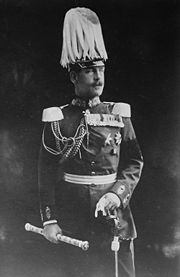
Picture - King Constantine I of Greece in the uniform of a German Field Marshal, a rank awarded to him by German Emperor Wilhelm II in 1913.
In the aftermath of the victorious Balkan Wars, Greece was in a state of euphoria. Her territory and population had doubled and, under the dual leadership of Constantine and Venizelos, her future seemed bright. This state of affairs was not bound to last long, however. When World War I broke out, Constantine was faced with the difficulty of determining where Greece's support lay. His own sympathies lay with Imperial Germany ruled by his wife's brother, the Kaiser. Sophie, his queen, was popularly thought to support her brother as well, but it seems that she was actually pro-British; like her father the late Kaiser Frederick, Sophie was heavily influenced by her mother, the British-born Victoria. Venizelos was fervently pro-Entente, having established excellent rapport with the British and French echelons of power. He also was keenly aware that a maritime country like Greece could not, and should not, antagonise the Entente, the dominant naval powers in the Mediterranean. This latter point at least came across to the king, no matter where his personal sympathies lay. He finally chose a policy of neutrality. The bold, insubordinate general of a few years before now seemed content to risk nothing and would possibly settle for as much after the war was over. Unable to impose unconstitutionally his will upon the lawfully elected government, he chose to neutralise it for the time being.
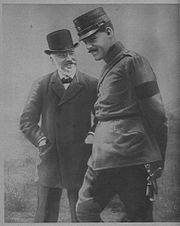
Picture - Constantine with Eleftherios Venizelos in 1913.
Constantine's sympathies for Germany were made manifest during the Allies' disastrous landing on Gallipoli. Despite support for Venizelos amongst the people and his clear majority in Parliament, Constantine opposed Venizelos's increasing support for the Allies. When Bulgaria attacked Serbia, with whom Greece had a treaty of alliance, Venizelos again urged the King to allow Greece's entry into the war, and permitted Entente forces to disembark in Thessaloniki in preparation for a common campaign over the king's objections. After Constantine refused again to support Greece's entry on the side of the Allies, however, Venizelos resigned, and Constantine appointed Alexandros Zaimis in his place, at the head of a short-lived coalition government.
In July 1916, arsonists set fire to the forest surrounding the summer palace at Tatoi, in what was popularly seen as a sign of dissatisfaction with the king's policy of neutrality. Although injured in the escape, the king and his family managed to flee to safety. The flames spread quickly in the dry summer heat, and sixteen people were killed. Although the Greek government remained officially neutral despite the presence of Allied troops in the second largest city, Thessaloniki, the Entente commander, French General Maurice Sarrail, declared martial law, effectively disbanding Greek authority in the areas under Entente control. In turn, in May and August 1916, parts of eastern Macedonia were allowed to be occupied, without opposition, by the Bulgarians without opposition by the nominally sovereign Athens government. Land gained by the blood of Greek soldiery was abandoned and not a finger was raised.
The country seethed with rage and in August 1916, an Entente-supported Venizelist revolt broke out in Thessaloniki. There, Venizelos established a provisional revolutionary government, which declared war on the Central Powers. With civil war apparently imminent, Constantine sought firm German promises of naval, military and economic assistance - without success. Gradually, and with Allied support, Venizelos gained control of half the country - significantly, most of the "New Lands" won during the Balkan Wars. This cemented the "National Schism", a division of Greek society between Venizelists and anti-Venizelist monarchists, which was to have repercussions in Greek politics until past World War II.
Early in 1917, General Sarrail ordered the Greek army to move from Thessaly to the south. He also ordered the Greek fleet to join the Allies and finally, Sarrail ordered the Greek government to adopt a more friendly attitude towards the Allies. In the face of a large Allied army in Greece, King Constantine left the country for Switzerland on 11 June 1917; his second-born son Alexander became king in his place. The Allied Powers were opposed to Constantine's firstborn son George becoming King, as he had served in the German army before the war and identified with his father's pro-German policies. General Sarrail was himself removed in November 1917 and replaced by a more diplomatic French General.
Restoration and disaster
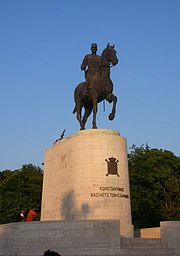
Picture - A statue of Constantine in Athens.
Constantine's younger son, King Alexander, died on 25 October 1920, after a freak accident: he was strolling with his dogs in the royal menagerie, when they attacked a monkey. Rushing to save the poor animal, the king was bitten by the monkey and what seemed like a minor injury turned to septicemia. He died a few days later. The following month Venizelos suffered a surprising defeat in a general election. Greece had at this point been at war for eight continuous years: World War I had come and gone, yet no sign of an enduring peace was near. All young men had been fighting and dying for years, lands lay fallow for lack of hands to cultivate them, and the country, morally exhausted, was at the brink of physical exhaustion. The pro-royalist parties promised peace and prosperity under the victorious Field Marshal of the Balkan Wars, him who knew of the soldier's plight because he had fought next to him and shared his ration. Following a plebiscite in which nearly 99% of votes were cast in favor of his return, Constantine returned as king on 19 December 1920. This caused great dissatisfaction not only to the newly liberated populations in Asia Minor, but also to the Great Powers who opposed the return of Constantine.
Within two years the king's new-found popularity was lost again. The inherited ongoing Asia Minor Campaign against Turkey proved disastrous for the Greeks. An ill-conceived and worse-executed plan to go for the jugular again, Kemal's new capital of Ankara, deep in barren Anatolia where no Greek lived, succeeded enough only to raise some faint and ill-fated hopes. The Turks eventually broke the overstretched Greek front and routed the Greek army through Anatolia to the shore, burning Smyrna. Following an army revolt, Constantine abdicated the throne again on 27 September 1922 and was succeeded by his eldest son, George II.
Second Exile and death
He spent the last four months of his life in exile in Italy and died in 1923 at Palermo, Sicily. His queen, Sophie of Prussia, was never allowed back in Greece. A life and reign that had started under the brightest of auspices ended in ruin.
Marriage and issue
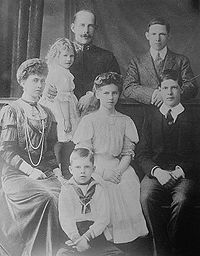
Picture - Constantine with his family, ca. 1910. Top left: the king holding the toddler Princess Irene. Top right: the future George II. Left: Queen Sophia. Center: Princess Helen. Right: the future Alexander I. Front: the future Paul I. Princess Katherine is yet unborn.
Constantine and Princess Sophie of Prussia married on 27 October 1889 in Athens. They had six children:
Ancestors
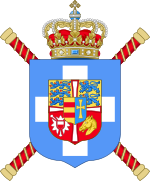
Picture - Coat of Arms of King Constantine I of Greece, as a Field Marshal of Greek Army.
Citations and notes
Darling, Janina K. (2004). "Panathenaic Stadium, Athens". Architecture of Greece. Greenwood Publishing Group. ISBN 0-313-32152-3. http://books.google.com/books?id=4F-v35--l_gC&dq=Panathenaic+Stadium,+Averoff,+Constantine&source=gbs_summary_s&cad=0.
Young, David C. (1996). The Modern Olympics: A Struggle for Revival. JHU Press. ISBN 0-801-87207-3.
Van der Kiste, John (1994). Kings of the Hellenes. Sutton Publishing. ISBN 0-7509-2147-1.
Polykratis, Iakovos Th. (1945-1955). "Constantine". In Passas Ioannis (in Greek). Encyclopedia "The Helios". XI. Athens.
Michalopoulos, Dimitris, "Constantine XII, King of the Hellenes. An outline of his personality and times", Parnassos, vol. 46, pp. 355-360.
More aircraft.
Source: WikiPedia